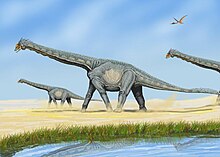Sauropod hiatus
It may represent an extinction event, possibly caused by competition with ornithischian herbivores, habitat loss from the expansion of the Western Interior Seaway, or both.
Definite evidence of Late Cretaceous sauropods in North America was first discovered in 1922, when Charles Whitney Gilmore described Alamosaurus sanjuanensis.
[1] The term "sauropod hiatus" was coined by researchers Spencer G. Lucas and Adrian P. Hunt in 1989 to describes how fossils of the clade become scarce in western North America near the beginning of the Late Cretaceous.
Lucas and Hunt proposed two hypotheses: a lack of properly preserved remains or a genuine extinction followed by re-population from South America.
[3] In the first scenario—rejected by Lucas and Hunt themselves but later further explained by Thomas Lehman in 2001—as sea levels rose, the sauropods became restricted to upland environments that were not as well represented in fossil record as coastal ones, before eventually migrating back to lowland areas as they became more suitable.
[2] In the second, the North American sauropods became extinct, and those that appear near the end of the Cretaceous represent immigrants from South America via land bridges, belonging to a group known as titanosaurians.
As for potential sampling bias, they explained how other groups of dinosaurs from the same areas as sauropods persist into the Late Cretaceous, while members of the clade itself disappear at around 98 Mya.
In contrast to an earlier argument by Mannion and Upchurch that this event took place before the sauropod hiatus, D'Emic and Foreman write that it occurred gradually over millions of years.
Alternatively, in a scenario doubted by Lucas and Hunt but taken into further consideration by D'Emic and Foreman, hadrosaurs (duck-billed dinosaurs) could have out-competed sauropods.
[17] Due to its large size, Alamosaurus is estimated to have contributed to the evolution of gigantism in North American Tyrannosauridae species such as Tyrannosaurus,[18] with whom it lived alongside.
[20] Sauropods have been considered poorly adapted for high-latitude environments, which would have made the Bering land bridge between Asia and North America inhospitable for titanosaurs.


